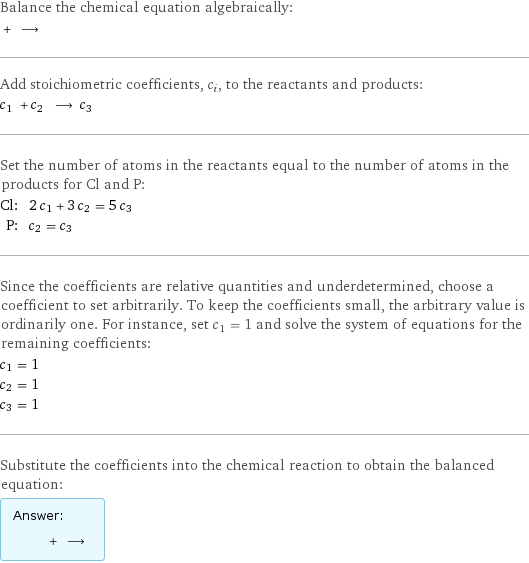Input interpretation

chlorine + phosphorus trichloride ⟶ phosphorus pentachloride
Balanced equation

Balance the chemical equation algebraically: + ⟶ Add stoichiometric coefficients, c_i, to the reactants and products: c_1 + c_2 ⟶ c_3 Set the number of atoms in the reactants equal to the number of atoms in the products for Cl and P: Cl: | 2 c_1 + 3 c_2 = 5 c_3 P: | c_2 = c_3 Since the coefficients are relative quantities and underdetermined, choose a coefficient to set arbitrarily. To keep the coefficients small, the arbitrary value is ordinarily one. For instance, set c_1 = 1 and solve the system of equations for the remaining coefficients: c_1 = 1 c_2 = 1 c_3 = 1 Substitute the coefficients into the chemical reaction to obtain the balanced equation: Answer: | | + ⟶
Structures

+ ⟶
Names

chlorine + phosphorus trichloride ⟶ phosphorus pentachloride
Chemical names and formulas

| chlorine | phosphorus trichloride | phosphorus pentachloride Hill formula | Cl_2 | Cl_3P | Cl_5P name | chlorine | phosphorus trichloride | phosphorus pentachloride IUPAC name | molecular chlorine | trichlorophosphane | pentachlorophosphorane
Substance properties

| chlorine | phosphorus trichloride | phosphorus pentachloride molar mass | 70.9 g/mol | 137.3 g/mol | 208.2 g/mol phase | gas (at STP) | liquid (at STP) | solid (at STP) melting point | -101 °C | -112 °C | 148 °C boiling point | -34 °C | 76 °C | density | 0.003214 g/cm^3 (at 0 °C) | 1.574 g/cm^3 | 3.6 g/cm^3 solubility in water | | decomposes | reacts surface tension | | 0.0291 N/m | dynamic viscosity | | 5.29×10^-4 Pa s (at 25 °C) |
Units
